


Framed or unframed, desk size to sofa size, printed by us in Arizona and Alabama since 2007. Explore now.
Shorpy is funded by you. Patreon contributors get an ad-free experience.
Learn more.

- Roll your own
- Rugged and real!
- A Charles Purcell - Mama Cass Connection
- Uncle SAAM
- Obfuscation
- One Chocolate Soldier rode away
- Victor Marquis de la Roche
- The Little House Across Way ...
- Vanderbilt Gates
- Vanderbilt Mansion
- You can still see that gate
- Withering heights for me
- So Jim,
- Top Heavy
- Re: Can't Place It.
- Bus ID
- Since you mention it
- The White Pages ?
- Moonlight Tower
- 1907?
- Fire(men) and Water
- Can't Place It
- Can anyone
- Wings
- Where's Claudette and Clark?
- Overbuilt Rolodex
- One song
- Give Me Wings Please!
- PRR
- Pinball Wizards
Printporium
Too Much Fun: 1905
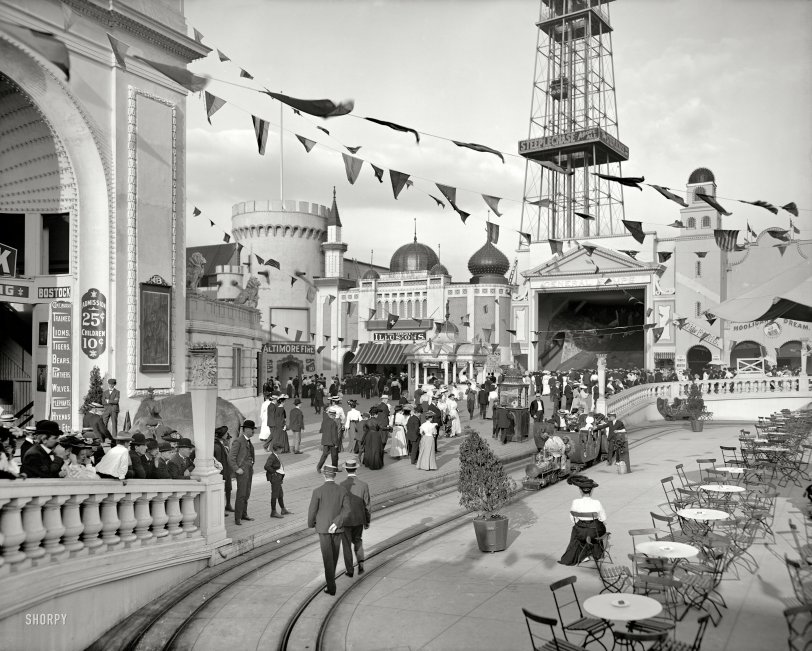
New York circa 1905. "Dreamland Park at Coney Island." Among the amusements to be sampled: An observation tower, the Bostock trained animal show, a Baltimore Fire cyclorama, the General Bumps ride, a miniature railway, Will Conklin's Illusions, the Temple of Mirth and Hooligan's Dream. 8x10 inch dry plate glass negative, Detroit Publishing Company. View full size.
All in the Family
Yes, a great number of the 'Cagneys' (as they were known) were built in the Niagara shop of Thomas and Peter McGarigle; however, since their sister Winifred married Timothy Cagney, it was considered to be all in the family. Peter—an engineer—was mostly likely the one who designed the first of the miniature locomotives, ostensibly in 1885. In the early 1890s Timothy and his brothers David and John, were running a ticket brokerage company known as Cagney Bros. in New York, but by 1898 decided to fully concentrate on marketing the McGarigle locomotives and so incorporated The Miniature Railway Company, of Jersey City.
For years the two businesses were nearly indistinguishable from one another, and were in fact interchangeable as far as miniature railways were concerned, as they worked together on various projects. In 1903 the Cagney Bros. Co. was ensconced in the Planter's Hotel in St. Louis—there to build the eight mile miniature railroad that would run through the grounds of the St. Louis Purchase Exposition (the 1904 World's Fair). Timothy Cagney was listed as President, and Peter McGarigle as Chief Engineer. While the Cagney Brothers' Miniature Railway Company was selling the vast majority of the McGarigle railroad oriented output, the Niagara firm was still peddling their own product as late as 1915 when they made a proposition to the City of San Francisco to operate a miniature railway in the park.
By the 1920s however, the Cagney Bros. had absorbed the miniature railway portion of the McGarigle Machine Company, and McGarigle's—once also known for their gasoline marine engines—appears to have been reduced to being an automotive machine shop. The locomotive building operation was now referred to as "the Cagney Brothers' Amusement Company Niagara Falls plant." By the 1940s the late Timothy Cagney—and not Peter McGarigle—was being given credit as the inventor.
According to one report, two of Cagney's "best known installations were two gold-plated trains with steam locomotives built for the King of Siam, and the 'Trip Around the World' exhibit at the New York World's Fair of 1939 and 1940."
As for the oil burner reference, it's from a list of Coney Island rides and shows complied by Kingsborough Community College Professor Emeritus (and former Brooklyn Borough Historian, director and archivist) John Manbeck. He complied a vast collection of Coney Island ephemera that has since been donated to the Brooklyn College Library. On his list of rides and shows is this entry:
A Miniature Railroad built by the Cagney Brothers made a circuit of park beneath the promenade. Each of its three small cars, pulled by a small oil-burning steam locomotive, held two passengers.
I do not know what his original source was (but I'll try to find out); however, while the vast majority of the McGarigle/Cagney locomotives were coal-fired, it makes sense that these would be oil-fired as it would have virtually eliminated the fear of sparks from the smoke stack—especially so soon after the disastrous 1903 fire.
Live Steam Model Fuels
There`s no guarantee or requirement that this locomotive is oil fueled. Even today Live Steam enthusiasts operating large scale locomotives are running with a variety of fuels. Propane is popular as is oil or kerosene. However coal is still the most popular fuel for ridable trains like this and can be used at gauges as small as 1.26 inches. So unless there were other considerations, like local laws, there`s a high likelihood that this engine was coal fired.
Pigmy Locomotive
While the Cagney Bros. operated many miniature railway concessions, the actual builder of this engine was the McGarigle Machine Co, of Niagara Falls, NY. Tobbacconist, is there something in the photo that indicates oil as the fuel source? The following article states the originals were built with a 10 inch firebox burning anthracite. I think this engine is coal fired. In 1905, coal was still a widely available and familiar fuel. Also, the trousers on the engineer appear rather well coated in coal dust. [Additional information and photos.]
The Railway Age, July 1, 1898.A Pigmy Locomotive.
What is claimed to be the smallest locomotive ever made for drawing passenger cars has been made for the Miniature Railroad company by Thomas E. McGarigle of Niagara Falls. This steam railroad is to be operated at the Trans-Mississippi Exposition in Omaha, Neb., and, in all, six locomotives are to be built for the company under the present contract. It is possible they will be used at other resorts, such as Coney Island, Atlantic City, Deal Beach, Washington Heights and Niagara Falls. …
The height of the locomotive from the top of the stack to the rail is 25 inches, and the gauge is 12½ inches. The cylinders are 2x4 inches. The boiler is 1½ horse power, made of steel, and is tested to 300 pounds pressure, and will hold 24 gallons of water. …
The firebox is 10 by 10 inches. The weight of this little engine is about 600 pounds, and it will run on a rail three-quarters of an inch square. Hard coal will be used as fuel. The capacity of the locomotive is 10 cars, each containing two persons, or about 4,000 pounds. The locomotive is equipped with sandbox, bell, etc., and has a steam brake between the drivers. One man, whose position will be on a seat in the tender, operates the engine. The scale on which the locomotive was built is about one-seventh that of one of the New York Central's largest engines, and as it stands in the shop it has a very businesslike appearance, as shown by the illustration.
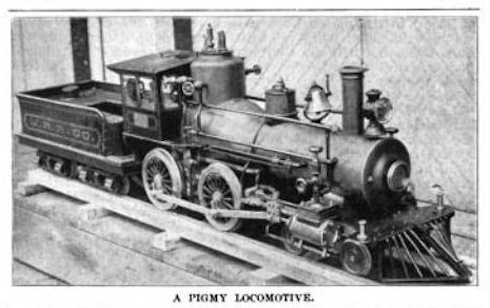
Oil burners
These were oil burning steam locomotives.
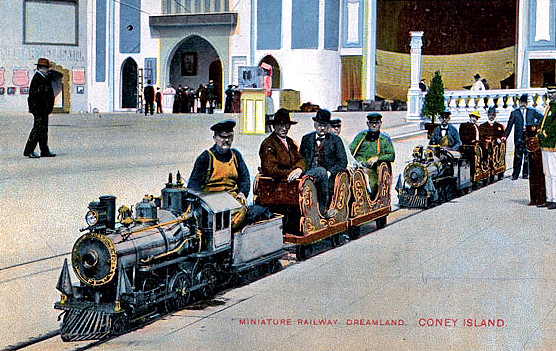
The Miniature Railroad was built by the Cagney Brothers in 1904 to replace an earlier version that was lost in a November, 1903 fire. It made a circuit of the park running underneath the promenade. The locomotives, which could pull three of the two-passenger cars, were built by the Cagney Brothers' Miniature Railway Company in New York. Their ad below is from the February 7, 1903 issue of The Billboard.
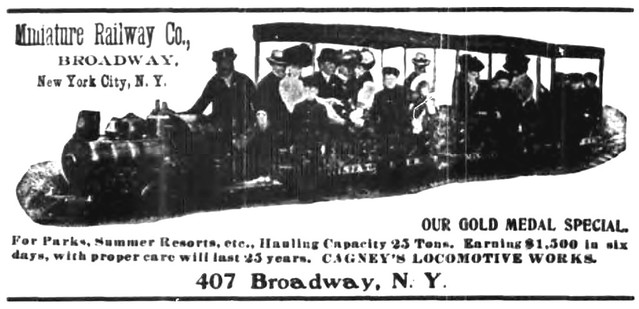
An earlier Shorpy post with a closeup of one of the locomotives has more information here, and a 1903 Edison silent movie of Coney Island before the fire (found here) shows the train emerging out from under the promenade at the 7:44 minute mark.
Live Steam?
I would assume that that little locomotive was actually a steam powered kerosene burner... does anyone know?
UPDATE: The kerosene assumption was (wrongly) made because I couldn't imagine firing a firebox that small with coal to maintain a working head of steam - Ausonius.
Bostock's Wild Animal Exhibition
Broadway Magazine, April 1905.Although Coney Island has improved greatly in the character of its shows within the last few years, the same atmosphere of careless holiday-making prevails, and you always have a feeling of jolly irresponsibility as you go from one place of amusement to another.
Bostock's wild animal exhibition in “Dreamland,” is again a prominent feature of the summer. The animals are interesting, whether in their dens or in the arena, while the trainers who put the savage creatures through performances in the large steel cage are as impressive as ever.
There was one act I saw at Bostock's lately which struck me as particularly good. A young lady in short skirts, who was announced as “La Belle Selika,” skipped into the cage with seven—I think it was seven—lionesses. She made them get up, reluctantly, upon pedestals in different parts of the cage. Then, as the orchestra struck up the music of the “Pretty Maidens,” in “Florodora,” she danced, teasing the animals by pointing her slippers at them one after another, and retreating just far enough to escape the angry paws darted at her each time. They seemed eager to tear her to pieces. She pirouetted about the creatures, always close to them, but just far enough away to avoid being clawed, until at last she struck an attitude immediately in front of the most savage of her pets and smiled in response to the applause, while the lioness growled. It was decidedly the prettiest act I ever saw in connection with trained wild animals, and it looked fearfully dangerous, whether it was so actually or not
The steam locomotive
has been hooked up to some pretty fancy oversized cars, and can you believe observing HYENAS for 25 cents, forget lions and panthers, they've got HYENAS !
Soon to be gone - again
Dreamland was rebuilt in early 1904 after a disastrous fire destroyed it in November, 1903. Six years after this picture was taken this scene was again destroyed by fire. It made news even in far away Australia where, two days later, the tragedy was reported by The Argus newspaper.
FIRE AT CONEY ISLAND.
AMUSEMENT PALACE DESTROYED.
DAMAGE 3,000,000 DOLLARS.
NEW YORK, May 27.
A destructive fire occurred yesterday at Dreamland, one of the great amusement resorts at Coney Island, New York. The damage is estimated at 3,000,000 dol. The menagerie was destroyed, 50 wild animals being cremated. The adjoining place of entertainment, Luna park, was saved.
[Dreamland and Luna Park practically constitute Coney Island, which is the greatest resort of its kind in the world. The resources of inventors are taxed to provide new thrills, with the result that each season finds some ingenious novelty installed for the New York clerk and shop-girl. Dreamland contains dozens of forms of entertainment. The visitor may travel by captive airship, or glide at fearful speed down the chute, through a cascade of real water. He may "loop the loop" in a car, or travel in a small chariot over an undulating sea of metal, the waves of which are caused by machinery below. The "Rocky Road to Dublin, " a fearful switchback apparatus, and "General Bumps," involving a hazardous slide down a polished wooden surface, are among the joys of the place; while those who desire to visit other lands may take a trip to the North Pole or the wilds of Central Africa with equal ease and cheapness.]
A more complete newspaper story with pictures of the aftermath can be found here, and a few more pictures can be seen here and here.
Where to look first?
There are so many wonderful aspects to this picture, I hardly know what to take in first. I love the "Temple of Mirth" (Can you imagine "mirth" being used on a ride today? How many folks even know what it means anymore?) I also love the "Hooligan's Dream" (but ditto on the meaning being mostly lost on 21st century folk). What REALLY intrigues me however, is what the people in the forefront are looking at instead of the elephants right behind them, which I would be fascinated by. Surely elephants weren't a commonplace sight.
[Happy Hooligan, whose image is in the circle on the sign, was an extremely popular comic strip character of the time. - tterrace]
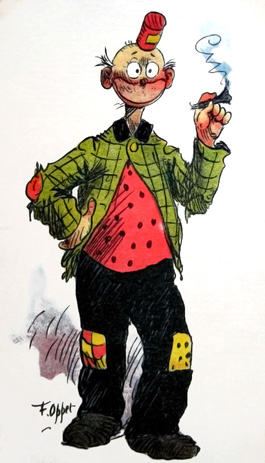
You Can't Miss Me
I'll be the one wearing a mustache a hat and a dark suit. The cops must have had an awful time with witness descriptions of the perps back then.
























On Shorpy:
Today’s Top 5